I learned to make dumplings a few years ago when we hosted an exchange student from China. Everyone in the family enjoys eating them, and the process is so fun!
Making dumplings, or jiǎozi, is definitely a social affair – it’s meant to be shared as a group. We enjoy making and eating them to celebrate Chinese New Year, and sometimes just for fun when we’re craving traditional Chinese food.
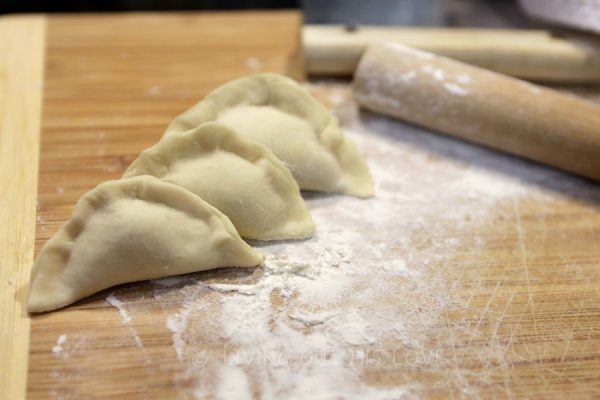
I was intimidated to make them at first, but I assure you it’s not hard! With some prep and a little time, you can enjoy traditional, authentic jiǎozi from scratch. I’m going to share a recipe that is very similar to the one our exchange student received from her mother. The filling is delicious and comes together quickly. You can use store-bought dumpling wrappers or you can make them yourself – I promise making wrappers is easier than you think, and it only require 2 ingredients.
You will need a Chinese-style rolling pin, like this one. Attempting to make wrappers with a traditional American rolling pin will not end well and I guarantee will only create frustration. I know from experience!
Wrapper Ingredients:
(makes about 32 wrappers)
2 cups all-purpose flour
3/4 cup just-boiled water (wait 90 seconds after bubbling has stopped)
Directions:
Put 2 cups of flour in a stand mixer while waiting for the water to boil. With the mixer going, slowly add the just-boiled water to the flour until a dough ball forms. Add more water or flour as needed to make a dough ball that’s not sticky. Knead the dough by hand for a minute (dough will be warm and someone rough), and then quickly place in a ziplock bag, making sure to squeeze out all the air before sealing. Set aside and let the dough rest for at least 20 minutes, but up to 2 hours.
Filling Ingredients:
While the wrapper dough is resting, mix up the filling…
2 cups of packed Chinese cabbage (I use Napa), chopped finely
1½ tbsp fresh, finely minced ginger root
3-4 cloves garlic, finely minced
½ cup fresh, finely chopped green onions
¹⁄₈ tsp ground white pepper
¼ water
2 tbsp regular soy sauce (not lite)
1½ tbsp Shaoxing or cooking wine
1 tbsp extra virgin olive oil
2 tbsp sesame oil
1 lb of ground meat (pork is traditional but I prefer 93% lean turkey)
Directions:
Combine all of the ingredients together in a bowl, keeping the meat refrigerated until adding it at the end.
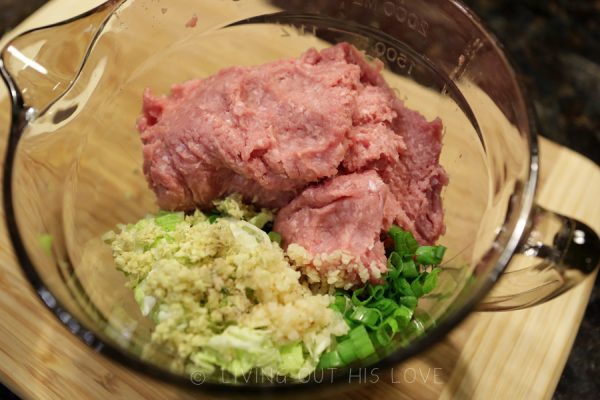
Next it’s time to make the dumplings:
1. Take the dough ball out of the ziplock bag and knead it on a floured surface for a few minutes. The dough will be wet from the condensation in the bag, and will need a little flour kneaded into it. Place the dough ball on your work surface and keep covered with a towel to retain moisture.
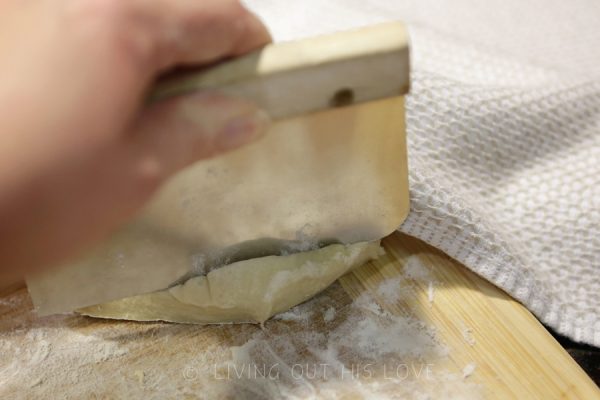
2. Cut off a small ½-ounce piece of dough (you will need to use a kitchen scale) and roll into a ball. With your hand, flatten the ball on your work surface to make a circle.
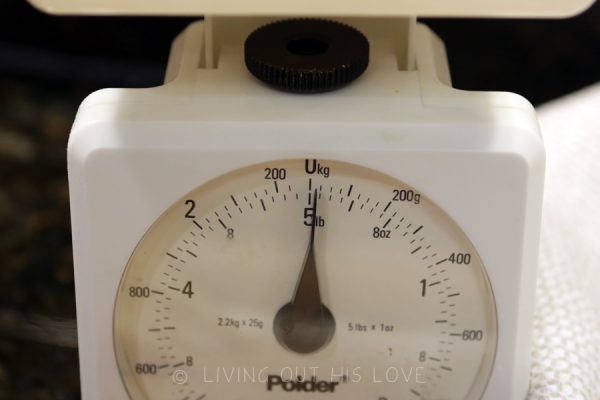
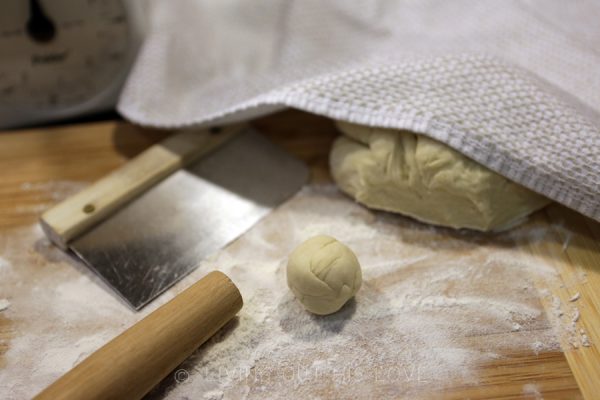
3. Using your Chinese-style rolling pin, roll out the dough, leaving the middle slightly thicker than the outside. To do this, roll from the middle out and rotate the dough, working your way around the whole wrapper. The wrapper should be thin (especially on the edges) and large enough to fit in the palm of your hand.
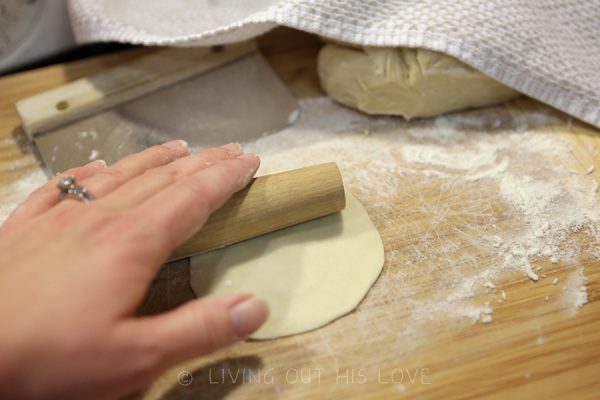
4. Spoon about 1 tablespoon (depending on the size of the wrapper) of the filling into the middle of the wrapper. Make sure not to over-stuff the wrappers, or they will be difficult to close.
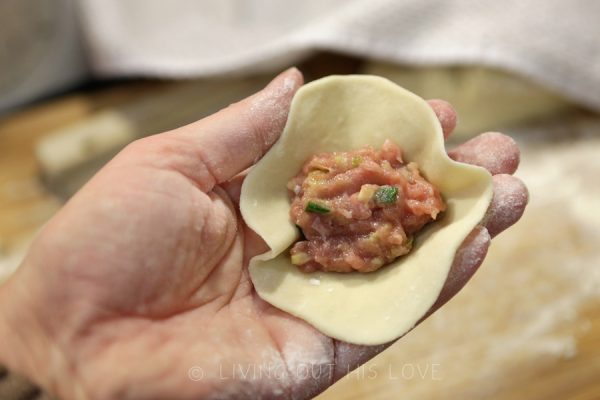
5. Fold the dough in half over the filling to create a half-moon shape, and then press the sides together. Make sure to squeeze out any excess air. Dumpling folding is a real art that I have not mastered. But if the dumplings stay closed, I feel pretty good about that.
Note: If you are using store-bought wrappers, you will need to use water to close the wrappers (dab your finger in water and run along the outside edge of the wrapper). This process is a lot easier if you are using homemade wrappers, because the dough sticks together without this extra step.
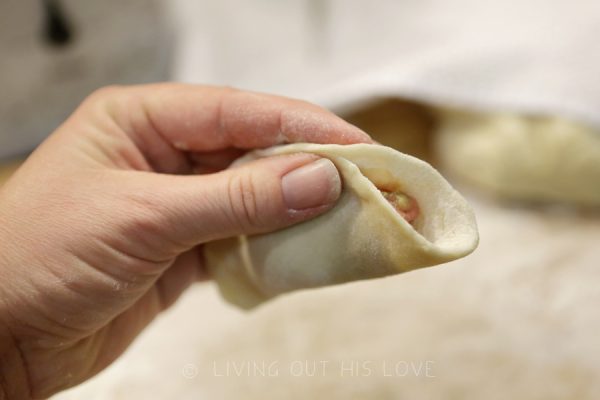
6. Place your finished dumpling on a tray and cover with a towel.
Repeat steps 2-6 over again until all of the dumplings are made. Remember, it goes much faster if you work as a team!

Next it’s time to cook the dumplings!
There are a couple methods to do this, with the easiest being boiling:
Boil: To do that, bring a large pot of water to a boil. Depending on the size of your pot, add about half the dumplings to the water and give them a gentle stir so they don’t stick together. When the water has returned to a boil, add ½ cup cold water to the pot. When the water has returned to a boil again, add another ½ cup cold water. When the water comes to a boil the third time, allow to boil for a few minutes. Then remove dumplings from the water. Use a meat thermometer or cut one open to make sure the dumplings are cooked through. Serve alone or with a dumpling dipping sauce of your choice.
Fry: Pan-frying dumplings is another delicious alternative! To do that, add 1 tablespoon of frying oil per every 5 dumplings to a frying pan. Add dumplings to the pan, pinched side up, when the oil is hot. Fry for about 1 minute, and then add ½ cup water to the pan. Bring to a boil. Cover and cook on low heat for 7-8 minutes or until the water has boiled away. Add 1 tbsp of oil to the pan, and then turn to medium heat. Cook off any leftover liquid, about 1 minute. Remove the dumplings from the pan and serve alone or with a dumpling dipping sauce of your choice.
Boil and fry: One last way to cook the dumplings is to boil first (with instructions above) and then pan-frying for a few minutes to make the outside wrappers crispy. Again, add dumplings to a hot pan with 1 tablespoon of oil for every 5 dumplings. Fry until the outside wrappers are crispy. Remove the dumplings from the pan and serve along or with a dumpling dipping sauce of your choice.
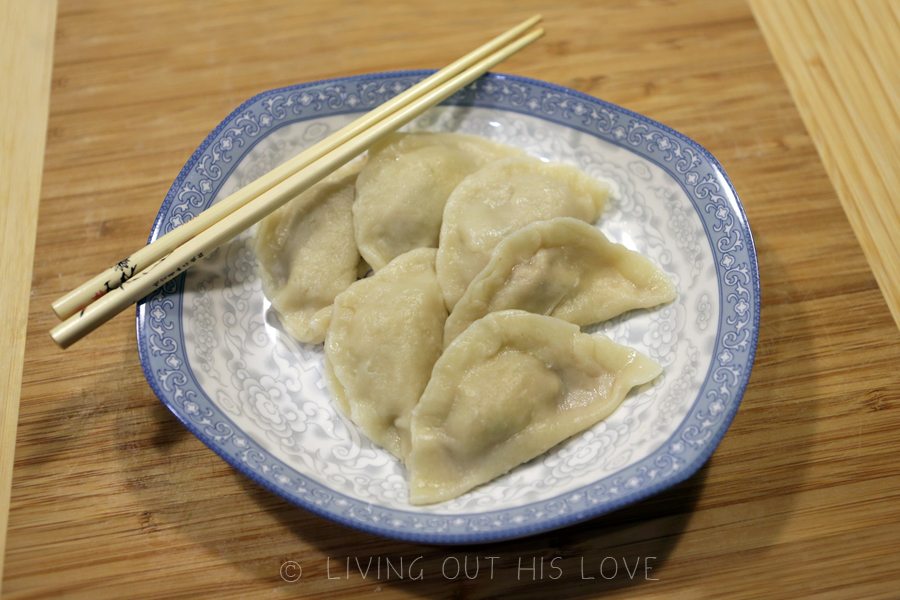
One last idea to keep in mind is that dumplings can be frozen and boiled directly from the freezer with the same directions as above. Also, extra dumpling filling can be frozen to use later. They are so versatile and are a fantastic snack to have on hand. And making them is a terrific way to celebrate Spring Festival with your family.
Xīn nián kuài lè wǒ de péng yǒu! Happy New Year my friends!


























Your dumpling recipe looks so good. I’m excited to try it. I also loved the dumpling skin recipe.
A simpler cooking method that I was taught and have used for years is to have the dumplings come to a boil and put in a whole cup or rice bowl of cold water. When the water boils again, the dumplings are done. Also to freezee dumplings, lay them on a plate or cookie sheet so that they’re not touching until they’re frozen. After they’re frozen you can put them in a bag and they won’t stick together.
Is that 1/4 cup of water?
My only criticism (and it is a small one) is that the jiǎozi should be shaped in a way that even uncooked (or after cooking) they should be able to stand upright on their base, not lie flat on their sides like dead little fish. Sadly, after a lot of practice, I still have not mastered this skill. The taste is not affected, of course, just the presentation.